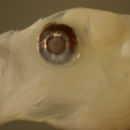en
names in breadcrumbs


Note: Earlier-stage larvae are somewhat different in appearance and it is not certain that these types all represent the same species. The fin-ray count is somewhat distinctive and all specimens share the count. A 7.1 mm SL larva with stubs of pelvic fins and melanophores in a row along the ventral midline of the abdomen and on the dorsal midline of the caudal peduncle resembles a larvae identified as Bollmannia communis by Ruple 2004 (Richards' goby chapter), but my larva has melanophores at the base of the lower caudal-fin rays not illustrated by Ruple and one fewer dorsal and anal-fin rays. Larger and transitional specimens, over 9.0 mm SL, are missing the midline abdominal melanophores, but share with the 7.1 mm SL specimen the fin-ray count, the melanophore at the angle of the jaw, the speckled membrane above the upper eyeball, the caudal peduncle melanophore (sometimes) and the large slightly underslung mouth, making it likely that they represent a single series of Bollmannia sp. The early-stage 5.9 mm SL larva shares the fin-ray count and the unusual irregular eye shape with the 7.1 mm SL specimen.
Description: Body thin, long, and narrow with a large eye and mouth. Pectoral fins long, pelvic fins long (in larvae above 9 mm SL, stubs in 7.1 mm SL and less), dorsal and anal-fin bases medium length, caudal peduncle long, and narrowing rapidly, 8-9 procurrent caudal-fin rays (8 spindly). Lightly marked mostly along the ventral midline: melanophores in streaks at the posterior isthmus and along the pelvic-fin insertion, then four midline melanophores along the abdomen (only in the 7.1 mm SL larva), the last just forward of the vent, then a row along the anal-fin base behind the second anal-fin element (variably paired, one per side) and then a long streak extending along the ventral midline of the caudal peduncle ending near the start of the procurrent caudal-fin rays. There are melanophores at the base of some of the lower segmented caudal-fin rays. The only dorsal marking is a melanophore on the dorsal midline of the caudal peduncle some distance after the last dorsal-fin ray (missing in some individuals). There are melanophores at the angle of the jaw in the larvae over 7.0 mm SL. There are internal melanophores along the dorsal surface of the swim bladder and around the gut near the vent. The eye is unusual, ranging from a large irregular oblong tilted forward with a ventral anterior indentation in the iris and a posterior-inferior iris extension in earlier-stage larvae becoming a moderately-narrowed vertical oval in the largest larvae. Larvae over 7 mm SL also have a speckled "eyebrow" membrane over the upper third of the eyeball that appears detached from the pigmented iris below.
Diagnosis: Modal fin-ray counts of D-VII,13 A-13 and Pect-20-22 indicate Bollmannia boqueronensis or Parrella macropteryx. second-dorsal-fin elements 12-15 and anal-fin elements 12-14 with equal numbers of elements and high pectoral-fin-ray counts are only found in these two genera (Gobionellus spp., Gobioides, and Microgobius all have more than 15 anal-fin elements). Median-fin ray counts are variable in the two genera with some species having more anal-fin rays than second-dorsal-fin rays. B. boqueronensis has a mode of 13 second dorsal and anal-fin elements and 20-21 pectoral-fin rays. Other regional species comprise B. litura with 12 second dorsal and anal-fin elements and 20 pectoral-fin rays, B. eigenmanni with 12 second dorsal and 13 anal-fin elements and 23-25 pectoral-fin rays, and B. communis (USA to Campeche) with a mode of 15 second dorsal and 14 anal-fin elements and 22 pectoral-fin rays. Parrella macropteryx, the only species of its genus in the Atlantic, cannot be excluded from the larval type (D-VII,11-14 A-13, pect. count?). Some other gobies overlap the median-fin soft ray counts, but all have six first-dorsal-fin spines: Oxyurichthys stigmalophius with one more anal than dorsal-fin rays (D-13 A-14, Pect-21-22), a few Ctenogobius species (but they have many fewer pectoral-fin rays), and Vomerogobius flavus (D-VI,12-13 A-13, but Pect-15-16). (U)